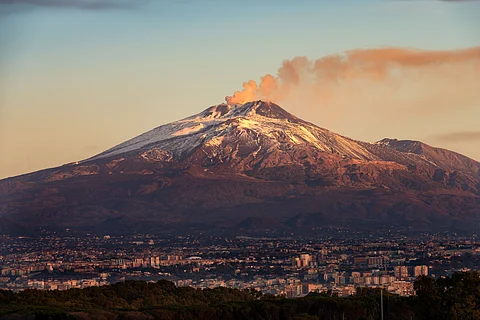
- Destinations
- Experiences
- Stay
- What's new
- Celebrating People
- Responsible Tourism
- CampaignsCampaigns
- Subscribe
- Buy Now

Mount Etna, Europe’s largest and most active volcano, has erupted on the Italian island of Sicily, sending plumes of smoke into the air on June 2.
The volcano is one of the world’s most active. Italy’s National Institute of Geophysics and Volcanology said the eruption began around 3:50 AM local time, following volcanic tremors which started around midnight local time.
The institute said eruption activity continued with “increasing intensity” but has now stopped.
A pyroclastic flow, which is an avalanche of hot rock, ash and gas, was witnessed on Mount Etna surveillance cameras at around 11:30 AM local time. This flow doesn’t appear to have crossed the edge of the Valle del Leone, a valley located at the foot of the summit craters on Mount Etna.
The Volcanic Ash Advisory Centre in Toulouse issued a red aviation warning, but subsequently downgraded this to orange after the ash cloud dissipated and drifted north-west.
Local officials said there was no immediate threat to the residents of the area, despite the fact that panic spread among the tourists.
Mount Etna sits in a national park near the port city of Catania, filled with a wealth of Baroque architecture and popular with those looking to head off to the volcano’s foothills, covered with ash hills and lava rocks on guided hikes.
Despite frequent eruptions, lava has not reached nearby towns since the 1800s. Etna has more than 200 craters, and when one of these does erupt, black volcanic ash lands in the city of Catania at its foot and the many surrounding towns and villages.
This is inconvenient for residents, but usually not a problem for visitors. Some people even purposefully climb the volcano to see an eruption, though authorities urge tourists to keep a safe distance.
Sicily has four main international airports: Catania-Fontanarossa (CTA), Palermo-Falcone Borsellino (PMO), Trapani-Birgi (TPS) and Ragusa-Comiso (CIY).
All four airports appeared to be carrying on with their flight schedule as normal as of midday Monday, with very little disruption. Catania has seen some minor delays in flights departing Monday morning, the longest being just over an hour.
When eruptions happen, the airport typically tells travellers to verify the status of their flights with their airline before departing because volcanic activity can cause things to change rapidly.
Stay informed: Monitor official updates from local authorities and the National Institute of Geophysics and Volcanology for real-time information on volcanic activity.
Check flight status: Verify your flight status with your airline before heading to the airport as volcanic activity can lead to sudden changes in flight schedules.
Health precautions: If you have respiratory issues, consider wearing a mask and limiting outdoor activities during periods of ashfall.
Guided tours: If you're planning to visit areas near the volcano, consider joining a guided tour to ensure safety and gain expert insights into the volcanic activity.
(With inputs from multiple news reports)
